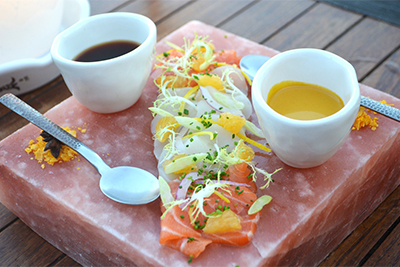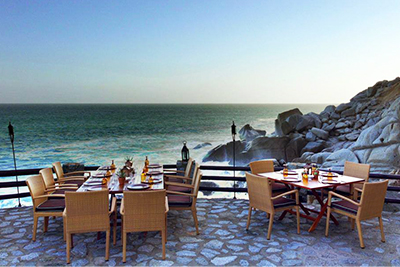
Yvan Mucharraz was destined to join the Mexican Navy. Both his father and brother were in the military, and at the tender age of 14, he decided to enroll. But after a year-and-a-half in uniform, he knew it wasn’t for him. He needed an outlet for his creativity and found that through his love of food.
His big break came when Forbes Travel Guide Tastemaker Thomas Keller visited the Rosewood Mayakoba resort in Riviera Maya. Mucharraz, a sous chef there at the time, created a tasting menu for Keller. After a couple of meals and conversations, chef Keller invited him to stage at Five-Star The French Laundry, which led to a job as chef de partie under then-chef de cuisine Tim Hollingsworth, and later, a three-month stage under Joël Robuchon in Paris.
Mucharraz joined the exclusive Capella Pedegral resort in Cabo San Lucas as chef de cuisine in 2012. He was recently promoted to executive chef of the property, where he oversees the resort’s entire culinary operations.
We were fortunate to catch up with Mucharraz during a rare break from the kitchen to learn about what he’s doing at Capella Pedregal and to get tips on what to do away from the dining table during a vacation in Cabo San Lucas.
 Tell me about Mexican seaside cooking.
Tell me about Mexican seaside cooking.
Mexico is surrounded by the ocean, so it’s very traditional for us to have seaside cooking because we have many different kinds of fish. We have people come from around the world to do sport fishing in Mexico. We have bluefin tuna, yellowtail tuna, abalone, chocolate clams, kumamoto oysters, and sea urchin. We have a lot of products that Japanese [chefs] have to get from Mexico, and it’s impressive that we can get these products, especially here in the Baja.
What are some typical ingredients used in Mexican cooking?
I use what is seasonal and fresh. But in general, I use tomatoes, chiles, squash, and beans. These are kind of the basics, but there are fresh herbs that maybe people don’t know, like quelites and papaloquelite. We use a lot of fresh cilantro, all spices and different kinds of chiles: chipotle, guajillo, pasilla. Where possible, we source our product locally. Here at the resort, we have a special relationship with local organic farmers. A lot of the product is handpicked within one or two hours of arriving in our kitchen.
 You’re in charge of four restaurants at the resort, including El Farallón, Crudo, Beach Club and your signature restaurant, Don Manuel’s. Each one has different food. Tell me about the different concepts behind each.
You’re in charge of four restaurants at the resort, including El Farallón, Crudo, Beach Club and your signature restaurant, Don Manuel’s. Each one has different food. Tell me about the different concepts behind each.
El Farallón, our cliffside restaurant, is a fish market. We have local fish and local seafood that is completely fresh — we buy it daily. We grill it, sauté it or marinate it. The food is more rustic. So, you have the cliff, gorgeous ambiance, and simple grilled food, all outdoors with the waves crashing beneath you. El Farallón is only open for dinner. Then, there is Don Manuel’s, which is our fine dining restaurant, which is open for breakfast, lunch and dinner. The ambiance changes depending on the meal. For breakfast, the buffet looks like a market, and the food is what Mexicans normally eat for breakfast — huevos rancheros, huevos en cazuela, motuleños, scrambled eggs with salsas and fresh local fruits. For lunch, it’s more like pool items — fish tacos, shrimp tacos and ceviches. And then we have dinner, which will be more sophisticated flavors. The Beach Club is more American food — nachos, Tex Mex, different kinds of tacos, hot dogs and hamburgers. And then Crudo is a cevicheria, a raw bar.
What are some specialty items on the current menu at Don Manuel’s?
The menus change with whatever’s available in the season. Right now, on the menu at Don Manuel’s, we have different kinds of ceviches that are very unique. One of them is made with cucumber juice and Serrano chile emulsion. We add some red radish, turnips and celery, and mix all the flavors with parrotfish. It’s very nice. It is not one of the dishes you’ll find anywhere. It’s just something we like to make, and it’s very refreshing, because right now in Cabo, it’s very hot. Also, we’re doing caldo cantinero. Whenever Mexican people go to a cantina, the tradition is that as soon as you arrive and start ordering something to drink, the cantina will send some food to you. And one of the things that they send while you’re drinking is the caldo. Our caldo is made with shrimp, tomatoes and chiles, so it’s like a spicy shrimp broth.
Tell me more about the traditional Mexican food offered at the resort.
Whenever I do traditional Mexican food, I do it very traditional. For instance, we have conchinita pibil (slow-roasting pork in a banana leaf) on the menu, which is a traditional Yucatan recipe, and we serve it like it is. We don’t want to change anything. We like to keep the traditions intact. I put the traditional dishes on the dinner menu because I want to show people the difference between doing traditional foods passed down through generations and more contemporary Mexican cuisine.
What are your favorite restaurants in Cabo?
Honestly, that’s a hard question because I’m somebody who, whenever I’m not cooking and not in my hotel or restaurant, I don’t expect anything but simple, nice food. One of my favorite places to go is a taqueria called Asine Asado. They have really nice tortillas. They do tacos in front of you, and they have really nice quality of fresh chicken, seafood, fish and meat. And they also have at least 15 kinds of salsas and garnishes, so after they serve the taco, you can build your own as you wish. I like to have this experience whenever I’m off.
Tim Hollingsworth, your chef from the time you were at The French Laundry, raved about a small place you took him to 30 minutes outside of Cabo. Where was it and what was its specialty?
The name of the place is Art & Beer. If you take the highway toward Todos los Santos (a famous surfing destination), you will find this place in the middle of nowhere. They are very famous because they do clamato juice. The very first time I went there, it was actually with chef Tim. We ordered some clamatos, and then watched as one of the owners took at least 25 or 30 ingredients [to make the juice]. It was amazing. She put all the ingredients in, and then at the end, they opened fresh chocolate clams and scallops and they put it in there with littleneck clam juice and your choice of beer or tequila. Initially, when I watched her, I thought, “This is going to be interesting.” But when I tasted it, I was impressed, because it was super, super, super good.
When you’re not at the resort, what are your favorite activities to do in Cabo?
I like to ride motorbikes. In Cabo, it’s a good place to do it, because it’s very calm, the roads are very nice, and you don’t need to go super fast to enjoy the ambiance and the surroundings. The people who ride bikes love Cabo. Also, I like to do watersports like jet skiing. We have boat trips and scuba diving, which is really amazing here. More recently, I’m trying to get into the ATV and off-road trips — we have plenty of places to do it here. Sometimes, I like to relax, and just go to the beach and chill. I like to read a lot. Right now, I’m reading about Mexican history. It’s a history novel about how we achieved independence in Mexico and about some of the processes during the Mexican revolution.
Photos Courtesy of Mai Pham and Capella Pedregal

